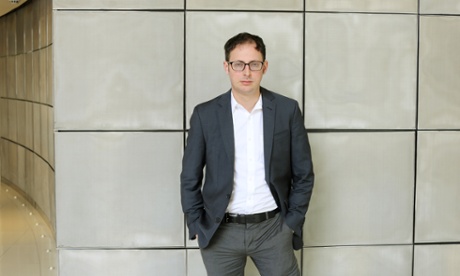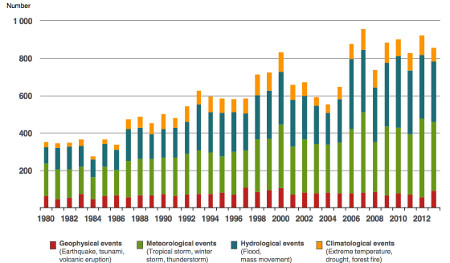by Dana Nuccitelli, "Climate Consensus - The 97%," The Guardian, March 25, 2014

Nate Silver's approach works well with politics and sports, but scientists do it better. Photograph: Graeme Robertson
Nate Silver and his "FiveThirtyEight" blog have grown quickly in prestige and popularity due to successful predictions of American political election outcomes, especially after biased "unskewed" analysis based on wishful thinking predicted the opposite of data-driven sites like Silver's and were proven wrong.
Silver recently launched a new FiveThirtyEight blog with the intent of applying this data-driven approach to a wide variety of subjects. He hired a variety of contributors to write about the subjects that are outside his expertise and comfort zone. For the topic of climate change, Silver decided to hire Roger Pielke, Jr.
Overall, the newly launched FiveThirtyEight seems to be taking a Freakonomics-style approach, looking for results that seem counter-intuitive. This approach worked well for Silver on the subjects of politics and sports, where much of the traditional analysis has been based on 'gut feelings' rather than on crunching data.
While data-driven analysis is laudable, when it comes to science, that's already the norm. Scientific research is based on crunching data, and scientists additionally have the expertise necessary to correctly interpret the results. The approach of looking for counter-intuitive results without first understanding the underlying science led to inaccurate climate chapters in SuperFreakonomics and Silver's The Signal and the Noise.
Thus many climate experts were concerned when they learned that Silver had hired Pielke. As Paul Krugman noted,
"...climate science has been developed by many careful researchers who are every bit as good at data analysis as Silver, and know the physics, too, so ignoring them and hiring a known irresponsible skeptic [Pielke] to cover the field is a very good way to discredit your enterprise ... Basically, it looks as if Silver is working from the premise that the supposed experts in every field are just like the political analysts at Politico, and that there is no real expertise he needs to take on board."
In addition to his history of making fundamental statistics errors, Pielke is also known for downplaying the links between global warming and extreme weather. Perhaps this was the counter-intuitive Freakonomics angle that appealed to Silver.
True to form, Pielke's first post at FiveThirtyEight argued that while damage costs from extreme weather events have risen in recent decades, that rise is not due to climate change. To defend this argument, Pielke showed that over the past two decades, disaster losses as a proportion of global gross domestic product (GDP) have not risen, and thus argued that the rise in costs is due to the fact that we've become wealthier – we have more stuff in the areas hit by extreme weather disasters.
It's true that some of the rising costs due to these disasters can be explained by increased wealth. Geophysical disaster events like earthquakes aren't becoming more frequent, but they are costing more than they used to. However, the costs of big storms and floods are rising faster than the costs of earthquakes, and unlike earthquakes, they're also happening more often. This suggests that something (i.e., climate change) is adding to the costs and frequency of these types of disaster events.
Hiding the Incline in Extreme Weather Damages
Pielke is a political scientist, but he has published some research in this area, attempting to 'normalize' disaster losses by accounting for population growth and increased wealth in hurricane-prone regions. In his research he's drawn similar conclusions to those in his FiveThirtyEight post, arguing that rising disaster costs can be explained by growing population and wealth.
However, Pielke's research does not account for the costs and avoided damages associated with mitigation efforts, for example improved building codes and hurricane path forecasting. This point was made by climate scientists Judith Curry in 2007:
"The second problem with the analysis is that the paper does not account for major engineering improvements that rendered these regions in Florida less susceptible to damage."
and Kevin Trenberth in Science in 2010:
"He completely ignores the benefits from improvements in hurricane warning times, changes in building codes, and other factors that have been important in reducing losses."
Pielke Misrepresents His Own Research
In a follow-up post on FiveThirtyEight, Pielke claimed that these technological advancements to mitigate disaster damages don't make a difference in damage trends "for floods, U.S. hurricanes or tornadoes." The problem is that the studies he references don't support his claims.
The reference regarding US hurricanes goes to one of Pielke's own papers, published in 2008. That paper specifically states,
"The normalization methodologies do not explicitly reflect two important factors driving losses: demand surge and loss mitigation. Adjustments for these factors are beyond the scope of this paper, but it is important for those using this study to consider their potential effect."
The paper includes a brief discussion of improved building codes in Florida potentially reducing disaster losses by over 40%, but suggests that "As strong codes have only been implemented in recent years and in some cases vary significantly on a county-by-county basis, their effect on overall losses is unlikely to be large." However, this speculation is not substantiated with any sort of analysis, does not include areas outside of Florida, and does not include mitigation measures other than improved building codes.
In fact, a study of Florida building performance found that homes built after 2002 sustained less average hurricane damage than those built between 1994 and 2001, which in turn sustained less damage than those built before 1994. This suggests that these types of technological improvements may have a significant effect on reducing disaster losses – an effect Pielke fails to account for.
Neglected Research Contradicts Pielke
Some other studies (not mentioned in Pielke's posts) have also found a trend in normalized hurricane damages that could potentially be partially attributed to human-caused climate change. For example, we know that global warming has caused sea level rise that leads to larger hurricane storm surges. Global warming adds more water vapor to the atmosphere, and the associated increased precipitation also adds to storm flooding. Warmer oceans also fuel stronger hurricanes.
Another fundamental problem in Pielke's post is that he looks for a climate change signal in extreme weather by analyzing economic disaster loss data instead of disaster frequency or intensity data. Pielke claims,
"When you read that the cost of disasters is increasing, it's tempting to think that it must be because more storms are happening. They're not."
Yes, they are, as data from Pielke's own source (reinsurance company Munich Re) clearly illustrates.
 Disaster event frequency data from Munich Re
Disaster event frequency data from Munich Re
Munich Re has also concluded that an increase in storm damages due to human-caused climate change is probably now detectable.
"For thunderstorm-related losses the analysis reveals increasing volatility and a significant long-term upward trend in the normalized figures over the last 40 years. These figures have been adjusted to account for factors such as increasing values, population growth and inflation ... In all likelihood, we have to regard this finding as an initial climate-change footprint in our US loss data from the last four decades."
Climate Scientists Know How to Analyze Climate Data
While Pielke's post has received extensive criticism (e.g., at Climate Progress, Things Break, The Huffington Post, Daily Kos, and Columbia Journalism Review), some have claimed that criticism is because he "flunked the green purity test" (i.e., National Journal). The latter argument falls prey to the false "honest broker" narrative. Pielke isn't criticized because of a lack of "purity," he's criticized because he consistently provides a skewed representation of the body of peer-reviewed science, downplaying links between climate change and extreme weather and only focusing on areas where those links are uncertain.
On FiveThirtyEight he's done even worse, making a number of false claims, including about his own research. That's why those who care about accurately representing the scientific literature criticize Pielke, and why people are concerned about the direction in which FiveThirtyEight is moving. Looking for counter-intuitive results in the data doesn't work well in areas like climate science, where the experts have already done a better and more thorough job of analyzing the data.
The bottom line is that many types of extreme weather are being intensified by human-caused global warming, and that will continue in the future. And there is evidence that climate change is adding to the costs of extreme weather damage. There's an important lesson for FiveThirtyEight to learn here – sometimes conclusions are counter-intuitive because they're wrong.







No comments:
Post a Comment